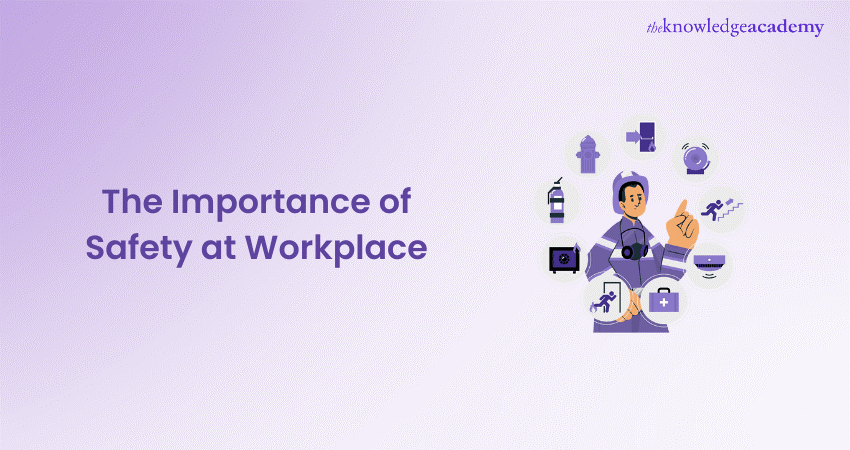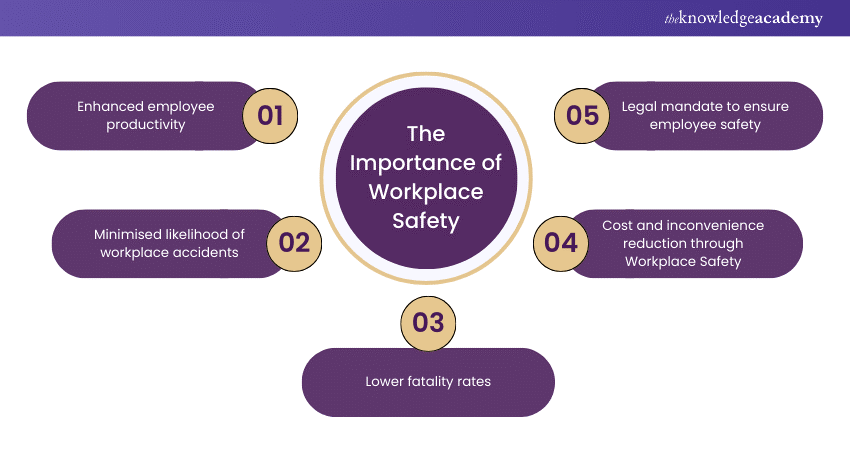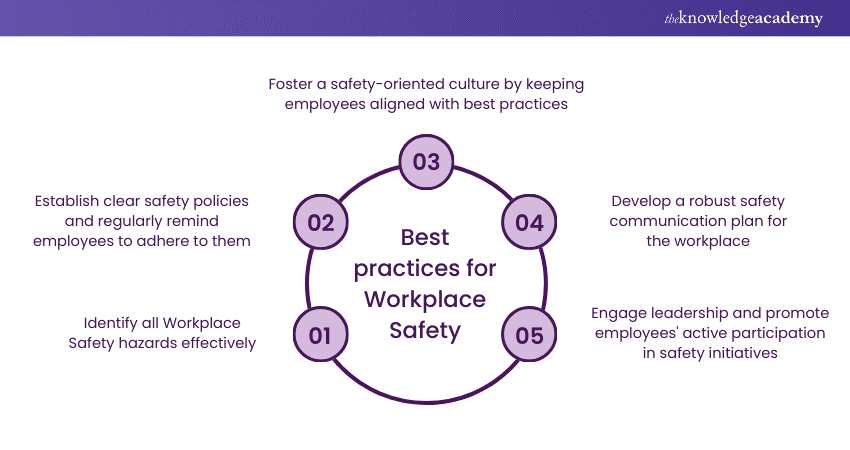We may not have the course you’re looking for. If you enquire or give us a call on + 1-866 272 8822 and speak to our training experts, we may still be able to help with your training requirements.
We ensure quality, budget-alignment, and timely delivery by our expert instructors.

Do you care about the safety and health of your employees and yourself? Or do you want to avoid the costs and inconveniences of workplace accidents, injuries, or illnesses? Maybe you need to comply with the legal and ethical standards of ensuring Safety at the Workplace. If any of these scenarios resonate with you, then you might want to learn more about the Importance of Safety at Workplace.
Safety in the Workplace is not only a legal requirement but also a moral and ethical duty. It is essential for both employers and employees to ensure a safe and healthy work environment. This blog will explain everything you need to know about the Importance of Safety at Workplace, such as the key reasons, the best practices, and the real-life examples.
Table of Contents
1) The Importance of Workplace Safety: Five key reasons
a) Enhanced employee productivity
b) Minimised likelihood of workplace accidents
c) Lower fatality rates
d) Cost and inconvenience reduction through Workplace Safety
e) Legal mandate: Ensuring employee safety
2) Best practices for Workplace Safety
3) Conclusion
The Importance of Workplace Safety: Five key reasons
Here are five key reasons illustrating the Importance of Workplace Safety:

1) Enhanced employee productivity
One of the main benefits of Safety in the Workplace is that it boosts the productivity of the employees. When the workers feel safe and comfortable in their work environment, they are more likely to perform better, be more creative, and have higher morale.
A secure and healthy work environment can also foster a positive and collaborative work culture where the workers can communicate effectively, share ideas, and support each other. This can lead to improved innovation, quality, and customer service.
On the other hand, an unsafe and unhealthy work environment can harm the employees’ productivity and performance. Exposure to hazards, such as noise, dust, chemicals, or violence, may cause the employees to experience physical or mental issues, including headaches, allergies, infections and anxiety.
These can affect their concentration, motivation, and decision-making abilities. They may also suffer from stress, fatigue, or burnout, which can reduce their work quality and output. They may also have lower morale and engagement and higher absenteeism and turnover rates.
2) Minimised likelihood of workplace accidents
Another benefit of Safety at the Workplace is that it reduces the chances of workplace accidents, injuries, or illnesses. These can have severe consequences for both the employees and the employers, such as physical pain, emotional trauma, medical expenses, legal liabilities, compensation claims, lost work hours, and damage to equipment or property.
Workplace accidents, injuries, or illnesses can occur due to various factors, such as human error, equipment failure, environmental hazards, or lack of training. Some of the common types of workplace accidents, injuries, or illnesses are slips, trips, falls, cuts, burns, sprains, fractures, electrocutions, suffocations, poisoning, infections, or chronic diseases. These can result in minor or major injuries, disabilities, or even death.
Employers can prevent or minimise these risks by implementing adequate safety measures and procedures and protecting their human and material resources. Some effective safety measures and procedures are providing personal protective equipment, conducting regular risk assessments, training the workers on safety protocols, maintaining and repairing the equipment, eliminating or reducing hazards, and enforcing the safety rules and regulations.
3) Lower fatality rates
A third benefit of Safety in the Workplace is that it lowers the fatality rates among workers. According to the International Labour Organisation, more than 2.3 million workers die each year from occupational accidents or work-related diseases, and another 500 million suffer from non-fatal injuries or illnesses. This is a tragic and unacceptable loss of life and health, which can be avoided or reduced by ensuring a safe and healthy work environment for all.
Work-related fatalities can occur due to various causes, such as falls from height, being struck by objects, exposure to fire, explosion, or electricity, contact with hazardous substances, or violence.
Some of the common work-related diseases are cancer, respiratory diseases, cardiovascular diseases, musculoskeletal disorders, and mental disorders. These can result from exposure to physical, chemical, biological, or psychosocial hazards, such as radiation, asbestos, pesticides, viruses, or stress.
By ensuring Safety in the Workplace, employers can lower the fatality rates among workers and prevent or reduce the suffering and grief of the workers and their families. Some ways to ensure Workplace Safety include complying with Occupational Safety and Health standards and regulations. Additionally, providing adequate medical care and insurance, monitoring and reporting occupational accidents and diseases, and promoting a culture of prevention and awareness are crucial measures.
Enhance workplace safety with our IOSH Managing Safely Course and equip yourself with essential skills to manage risks effectively.
4) Cost and inconvenience reduction through Workplace Safety
A fourth benefit of Safety at the Workplace is that it saves employers from the costs and inconveniences associated with workplace accidents, injuries, or illnesses. These comprise direct costs, such as medical bills, legal fees, insurance premiums, and compensation payments, as well as indirect costs, such as lost productivity, reduced efficiency, increased absenteeism, turnover, recruitment, and decreased customer satisfaction and loyalty.
Workplace accidents, injuries, or illnesses can impose a significant financial burden on employers, as they must bear the expenses of treating and compensating the affected workers and the legal fees and penalties if they are found liable or non-compliant. These costs are dependent on the severity and frequency of the incidents, the type and extent of the injuries or illnesses, and the legal and regulatory framework.
Workplace accidents, injuries, or illnesses can also cause a lot of inconvenience and disruption to the employers, as they must deal with the loss of work hours, reduced output and quality, increased errors and rework, decreased morale and motivation, and damaged reputation and image. These can affect the employers’ ability to meet the deadlines, expectations, and demands of their customers, partners, and stakeholders.
By ensuring Safety in the Workplace, employers can avoid or reduce these costs and inconveniences and improve their profitability and competitiveness. Some ways to ensure Safety in the Workplace are investing in safety equipment and training, implementing safety management systems and audits, reducing insurance claims and premiums, and enhancing customer satisfaction and loyalty.
Keen to establish a career in the field of Nebosh, refer to our blog on What is Nebosh.
5) Legal mandate to ensure employee safety
A fifth benefit of Safety in the Workplace is that it fulfils employers’ legal mandate to ensure their employees’ safety and health. According to the Occupational Safety and Health Act of 1970, employers must provide a work environment free from recognised hazards responsible for the death of employees or even causing them serious physical harm. Employers who fail to comply with this law can face penalties, fines, lawsuits, or criminal charges.
The Occupational Safety and Health Act of 1970 is the primary federal law regulating Occupational Safety and Health in the United States. It covers most private and public sector employers and employees. It sets the general duty clause, the Occupational Safety and Health standards, the enforcement and inspection procedures, and the employers' and employees' rights and responsibilities. The Act also establishes the Occupational Safety and Health Administration (OSHA), which administers and enforces the Act and the standards.
By ensuring Safety in the Workplace, employers can fulfil their legal mandate and avoid legal troubles and consequences. Some of the ways to ensure safety in the workplace include complying with OSHA and IOSH standards and regulations, cooperating with OSHA inspectors and investigators, correcting violations and hazards, and maintaining the necessary records and reports to ensure a safe working environment.
Gain globally recognised qualifications to excel in Occupational Safety and Risk Management with our NEBOSH Courses. Sign up now!
Best practices for Workplace Safety
To achieve the benefits of Safety in the Workplace, employers need to follow some best practices that can help them create and maintain a secure and healthy work setting for their employees. Here are some of the best practices that employers can adopt:

1) Identify all Workplace Safety hazards effectively
The first step to ensure Safety at the Workplace is to identify all the potential threats posing a risk to the workers' safety and health. These can include physical hazards, such as slips, trips, falls, fires, explosions, electrical shocks, exposure to harmful substances, and psychological risks, such as stress, harassment, violence, or bullying.
Employers can use various methods, such as inspections, audits, surveys, or consultations, to identify these hazards and assess their severity and likelihood.
2) Establish clear safety policies and regularly remind employees to adhere to them
The second step to ensure Safety at the Workplace is to establish clear and comprehensive safety policies and procedures that can guide the workers on how to prevent, report, and respond to workplace hazards. These policies and procedures should be based on hazard identification and assessment results.
They should cover all Workplace Safety aspects, such as emergency preparedness, incident reporting, first aid, first aid signs, personal protective equipment, fire safety, ergonomics, etc. Employers should also regularly communicate these policies and procedures to the workers and remind them to adhere to them.
3) Foster a safety-oriented culture by keeping employees aligned with best practices
The third step to ensure Safety at the Workplace is to foster a safety-oriented culture within the organisation, where the workers are aware of, committed to, and involved in Safety at the Workplace. Employers can achieve this by keeping workers aligned with the best practices for Workplace Safety.
This includes providing them with adequate training, education, and information on safety issues. Moreover, encouraging them to report and correct any unsafe conditions or behaviours, rewarding them for their safety performance and suggestions, and soliciting their feedback and participation in safety initiatives are essential measures
Elevate your leadership skills and enhance Workplace Safety with our NEBOSH HSE Certificate in Health and Safety Leadership Excellence Training. Join today!
4) Develop a robust safety communication plan for the workplace
The fourth step to ensure Safety at the Workplace is to develop a robust safety communication plan where the workers can receive, share, and access relevant and timely Workplace Safety information. The employers can use various channels to communicate with the workers on safety matters and methods. Let’s explore some of them below:
a) Meetings
b) Newsletters
c) Posters
d) Signs
e) Emails
f) Intranet
5) Engage leadership and promote employees' active participation in safety initiatives
The fifth step to ensure Safety in the Workplace is to engage leadership and promote employees' active participation in safety initiatives. Employers can do this by ensuring that the top management and supervisors demonstrate their commitment and support for Safety at the Workplace. They can set an example, provide resources, enforce accountability, and empower the workers.
Employers can also encourage and enable the workers to participate actively in Workplace Safety. They can involve them in safety committees, teams, or initiatives, soliciting their input and feedback. Additionally, they can empower them to make decisions and take action to improve Safety at the Workplace.
Ensure a safer workplace environment with our comprehensive Health & Safety in the Workplace Courses.
Conclusion
In conclusion, the Importance of Safety in the Workplace cannot be overstated, especially in a Hybrid Workplace Strategy. By prioritising Safety in the Workplace, organisations foster a culture of care, reduce accidents, and enhance productivity, both remotely and in-office. It's crucial to recognise and address the Importance of Workplace Safety to ensure the well-being of employees and the success of the business.
Enhance your understanding of occupational health and safety regulations with our Best Practice in Occupational Health and Safety Regulation Training.
Frequently Asked Questions
How can employers promote safety awareness among employees?

Here’s how employers can promote safety awareness among employees:
1) Providing regular safety training sessions
2) Conducting safety drills
3) Displaying safety posters and signs
4) Encouraging open communication about safety concerns
5) Rewarding employees for practising safe behaviours in the workplace
What are the legal responsibilities of employers regarding Workplace Safety?

Employers have legal responsibilities to ensure workplace safety by providing a safe working environment, conducting risk assessments, implementing safety policies and procedures, providing necessary training and supervision, and complying with health and safety regulations and standards set by relevant authorities.
What are the other resources and offers provided by The Knowledge Academy?

The Knowledge Academy takes global learning to new heights, offering over 3,000 online courses across 490+ locations in 190+ countries. This expansive reach ensures accessibility and convenience for learners worldwide.
Alongside our diverse Online Course Catalogue, encompassing 19 major categories, we go the extra mile by providing a plethora of free educational Online Resources like News updates, Blogs, videos, webinars, and interview questions. Tailoring learning experiences further, professionals can maximise value with customisable Course Bundles of TKA.
What is the Knowledge Pass, and how does it work?

The Knowledge Academy’s Knowledge Pass, a prepaid voucher, adds another layer of flexibility, allowing course bookings over a 12-month period. Join us on a journey where education knows no bounds.
What are the related courses and blogs provided by The Knowledge Academy?

The Knowledge Academy offers various IOSH Courses, including IOSH Managing Safely Course and IOSH Working Safely Course. These courses cater to different skill levels, providing comprehensive insights into Why is Health and Safety Important.
Our Health & Safety Blogs cover a range of topics related to Workplace Safety, offering valuable resources, best practices, and industry insights. Whether you are a beginner or looking to advance your Workplace Safety skills, The Knowledge Academy's diverse courses and informative blogs have you covered.
Upcoming Health & Safety Resources Batches & Dates
Date
 IOSH Managing Safely Course
IOSH Managing Safely Course
Mon 26th May 2025
Mon 14th Jul 2025
Mon 22nd Sep 2025
Mon 24th Nov 2025
Mon 8th Dec 2025






 Top Rated Course
Top Rated Course



 If you wish to make any changes to your course, please
If you wish to make any changes to your course, please


